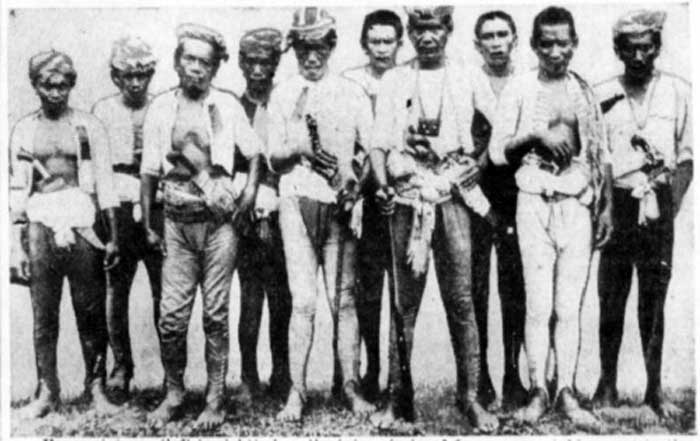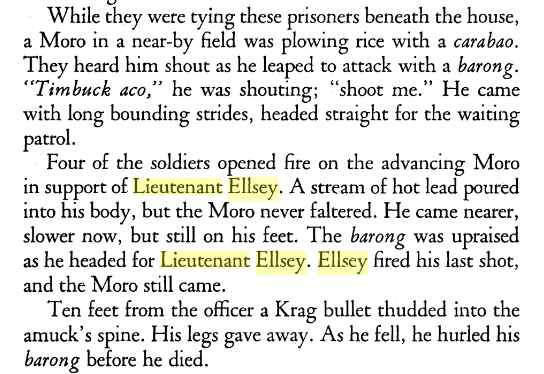Even the gun toting Spaniards feared the berserker swordsmen of the Philippines, the Juramentado.

Assassins and Holy Avengers
Not to be mistaken with people who have gone amok and enter a mindless killing spree, Juramentados (from the Spanish word ‘juramentar’ which means ‘who takes an oath’) are devoted Moros who underwent religious and spiritual oaths before engaging in their mission of killing high ranking officials and key figures during the reign of Spanish colonizers.
Although the practice began sometime after the arrival of Islam in the Philippines, the term “Juramentado” was first used by the commanding officer of the Spanish forces, Jose Malcampo, who entered and occupied Jolo, Sulu in 1876.
During the American occupation, incidents involving Juramentado assaults began to attract the attention of American commander Leonard Wood who sent reports to, then president, William Howard Taft. Their activity of “divine killing” would also become noticeable when the Japanese entered the Philippines.
To the Tausug of Jolo, the Juramentado’s practice was named “Parrang Sabbil“, a term borrowed from the Malay word Perang Sabif (perang=war and sabif=in the path of God). It was in their belief that to kill and be killed in the path (or name) of God would ensure the individual to enter paradise or heaven.

In the book “Parrang Sabbil: Ritual Suicide Among the Tausug of Jolo” by Thomas Kiefer, the ceremony to prepare an individual to take “the path to paradise” is similar to the rituals of the cleansing and purification conducted on a corpse. This includes bathing in their river while facing the four cardinal directions, shaving all their hair, and trimming their nails. Sexual activity was forbidden during the period of cleansing for they considered it to defile the body of the Juramentado.
After the cleansing, they would then wrap tight cords around certain parts of their body. This would prevent them from losing copious amounts of blood which could hinder their mission once they were injured. Peculiarly, their penis would also be bounded in cords to keep it erect. According to Kiefer, this was done to ensure the success of their mission and might imply a type of Homeopathic or Imitative Magic (mimicking the erected penis so that their body will be erect/upright and will not fail). After the long and complex ritual, the Juramentado would don a pure white cloth and turban. They would then choose a bladed weapon from their arsenal, such as the leaf-shaped sword Barong or Kris – a weapon with distinctive wavy blade patterns commonly seen in Indonesia as well as other parts of Malaysia, Thailand, Brunei, Singapore. In the Philippines, this is known as a Kalis.

Madmen or Skilled Fighters?
Numerous accounts have been recorded which entail the way the Juramentados executed their mission and the problems it caused for the authorities. Although their acts fall under the category of ‘assassination’, these Moro skirmishers didn’t utilize the advantageous strategy of stealth during their assault. To the Juramentado, attacking from the shadows was the way of cowards. They were entirely ready for death the moment they engaged in their suicidal practice. It is deeply etched in their mind that death is synonymous for their success and would ultimately lead them to paradise.
Their bravery and cunning tactics were narrated by John Foreman in his book “A Political, Geographical, Ethnographical, Social and Commercial History of the Philippine Archipelago Embracing the Whole Period of Spanish Rule with an Account of the Succeeding American Insular Government” (1906) wherein the Juramentados attacked white men in broad daylight without using any cover and always utilize full frontal assault. They could also manage to infiltrate heavily guarded towns using the underground drain pipes as their entry path.
In another account which is detailed in “Swish of the Kris, the Story of the Moros” by Vic Hurley, an unstoppable Juramentado had nearly slain Lieutenant Ellsey. It took a dozen of bullets and a hit on his spine to stop the brave rampaging Moro.

In 1911, a more powerful .45 caliber gun would be issued to the soldiers, replacing their .38 caliber pistol, for effectively stopping the assault of Juramentados. This model would ironically become the most iconic gun in the Philippines after the war. Policemen used it as their staple firearm while famous action stars, such as Fernando Poe Jr., would cement it in cinematic history. That is something that blows my mind!
Other Groups with Similar Beliefs
Pursuing the path of religion and spirituality through suicidal killings is not something exclusive to the belief of the Juramentados. A group of Berbers (an ethnic group from North Africa) called Circumcellions purposely attacked Roman soldiers with nothing but their crude wooden clubs; aiming to provoke them so they would retaliate and kill them. They believed that this was the way of martyrdom that would allow them to become one with Christ in heaven. Due to their unorthodox practices, they were considered heretical Christians during their time.
The extreme state of mind incorporated by the Moros can also be compared with the Berserker from Norse literature. These warriors were said to be Odin’s (the chief god in Norse mythology) champions and fought without any armor other than their animal skin clothing (which is parallel to the Juramentado’s white clothes). They were said to go into a trance when they furiously entered the battle.

A Warrior’s way towards the Divine
Fanatical. Overzealous. Insane. Savage. Some people might associate these words to the sacred suicide of the Juramentados. It sounds strange knowing that this bloody act was done in the name of holy God, but nonetheless, the Juramentados were not the only people in history who willingly shed both their blood and the blood of their enemies for the sake of divine purpose.
One can look at the Crusades, known now as the “holy wars”, where both Christians and Muslims fought to the death. Warriors of the past didn’t only fight with their trusted sword but also with their faith – a weapon that made them capable of doing the impossible and giving them hope that all the blood that was shed would be worth it in the end.
ALSO READ: Ancient Cultural Weaponry: Finding the Visayan Bakunawa Kampilan
Currently collecting books (fiction and non-fiction) involving Philippine mythology and folklore. His favorite lower mythological creature is the Bakunawa because he too is curious what the moon or sun taste like.


